The bull whose semen is worth $3,000
- Published
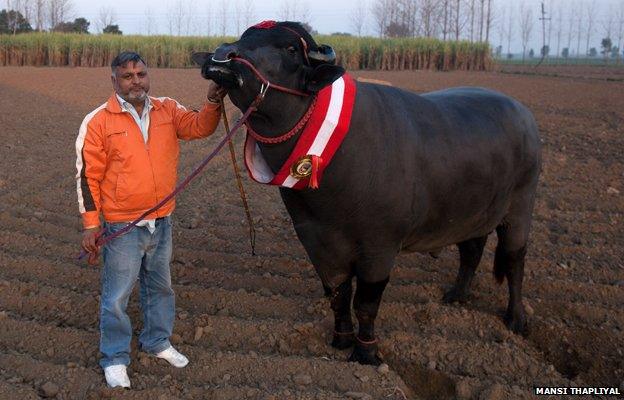
In the sprawling yard of a three-storey beige stucco building in a village in northern India, a large buffalo ambles around on yoga mats, his dark eyes sizing up the new visitors wearily.
Yuvraj is a handsome animal with oiled backward-curving horns, a smooth grey-black coat and a slim, bushy tail. He weighs 450kg (990lbs), is 10ft long and 5ft 8in tall. He is also used to attention - and slightly disdainful of his latest admirers.
"Every day somebody or the other comes to see him. He's not just another bull, he's a brand," says his proud owner, Karamveer Singh, a 47-year-old third generation farmer in Haryana state.
Singh lives in the village of Sunarion in a district - Kurukshetra - renowned as the place where a mythical battle was fought in India's best-known epic, the Mahabharata.
In real life, it is among the many villages in India where boundaries between city and countryside are blurring fast: prosperous farmers reside in large, well-appointed homes. Many of their children, first-generation college students, are enrolled in foreign universities.
The hard-working farmer Singh owns a herd of two dozen cows and buffaloes, runs a business and deals in property. He lives with his wife, half a dozen cars and tractors and a retinue of household servants. One of his sons is studying for an MBA in Australia; the other is studying computer science in Rajasthan.
But Yuvraj, named after an Indian cricket star, is his most prized possession. He's a Murrah bull - the best of the 13 recognised buffalo breeds in India - and a cash cow if ever there was one.
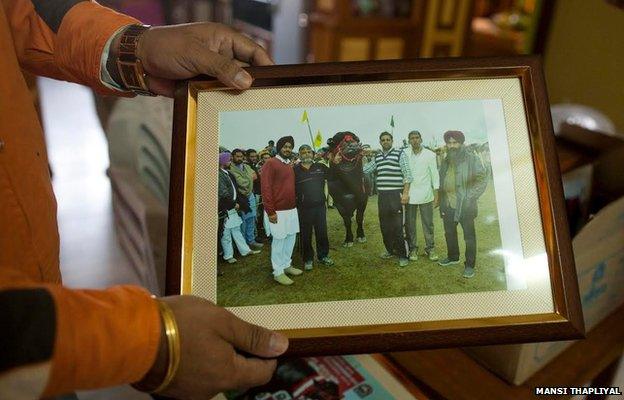
Inderjeet Singh, chief of India's Central Institute for Research on Buffaloes describes Yuvraj as a "champion breeding bull".
His semen is now possibly the most expensive in India, costing up to 350 rupees ($5.65; £3.75) a dose - possibly more than 10 times the average.
A single ejaculation, triggered with the help of a teaser animal and collected in an artificial vagina, provides 500 to 600 sperm "doses", each containing 20 million sperm. The upshot is that Singh earns anything between three and five million rupees every year selling the stuff, which he stores at home in thin frozen strips, preserved at -196C in 50-litre containers of liquid nitrogen.
Semen traders, armed with cryogenic flasks, drive from all over India to queue up at Singh's door. "We have come to buy Yuvraj's semen for the first time," says Lalit Chowdhury, from neighbouring Uttar Pradesh state. "I saw him at an animal fair in Meerut last year and people were raving about him. I want to sell his semen to farmers all over India now."

Yuvraj also earns money by winning state-sponsored buffalo and livestock contests, collecting up to 300,000 rupees ($4,853; £3237) each time. The spacious rooms in Singh's home glitter with the bull's trophies.
"I have never seen a healthier, productive and more handsome bull," says Inderjeet Singh.
Plenty of people would like to buy this wondrous animal. Two years ago, a businessman from the southern city of Hyderabad offered Singh 70 million rupees ($1.14m; £757,000). It was not enough.
"I would only consider selling him if I got an offer which was three times this offer," says Singh. "With that I could buy a helicopter." And then, in an afterthought, he mutters: "But should I be separating him from his family? Would I be able to live without him?"
It's a good question.
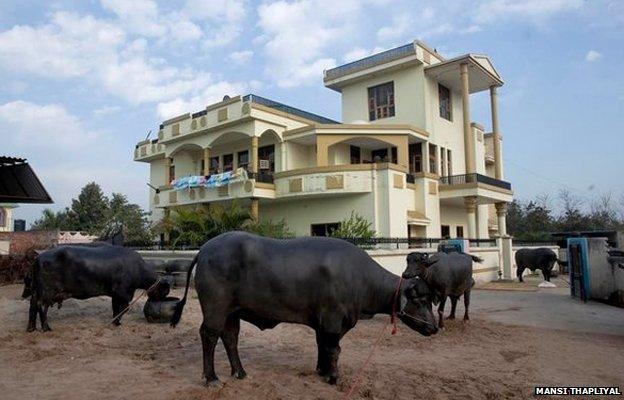
In a backyard, Yuvraj's family wanders around. There's his 19-year-old mother, Ganga, who's now pregnant for the 16th time, sluggish and sleepy under a sharp winter sun. She is a "milk powerhouse" producing 26 litres of milk every day, says Singh proudly. Three-year-old brother Bhim is chewing cud absent-mindedly. His 16-month-old sister, Saraswati, appears to be the quietest.
It all began when Singh bought Yuvraj's father, a bull he later named Yograj, from a farmer in Rohtak district for 37,000 rupees ($597; £397) 14 years ago. "The rest is history," he says.
But Singh's tender loving care has clearly helped to make Yuvraj the winner bull he is.
His two meals a day comprise 20 litres of milk nourished with tonics and vitamins, 10kg of apples, and an equal amount of fodder and grain. All this costs 2,000 rupees ($32; £21) per day. In the evening, two servants take Yuvraj for a brisk 5km walk on the farm.
"When I come back home after a hard day's work, the last thing I do before I go to bed is check whether Yuvraj is doing fine," says Singh.
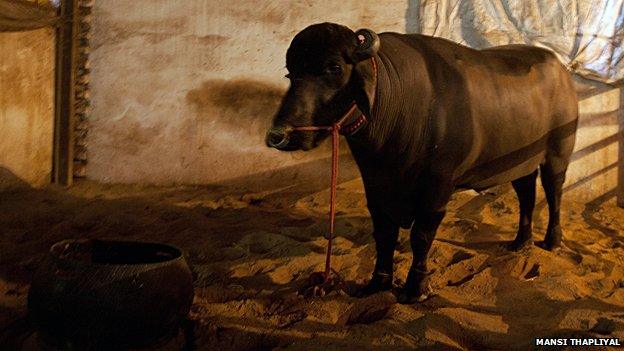
In biting winters, Yuvraj sleeps in a cosy sand-filled enclosure in a tarpaulin covered shed. In scorching summers, he's kept comfortable by air coolers positioned outside the enclosure.
Yuvraj needs to be rested well after coping with the incessant rush of visitors, says Singh. "People come from all kinds of places," he adds, "Canada, Brazil, Venezuela."
"They take pictures of his eyes, his coat, his horn, his tail. A scientist came from Brazil and said Yuvraj was the best bull he has ever seen.
"But you must come in summer to see him again. He looks more handsome then."

India's buffaloes
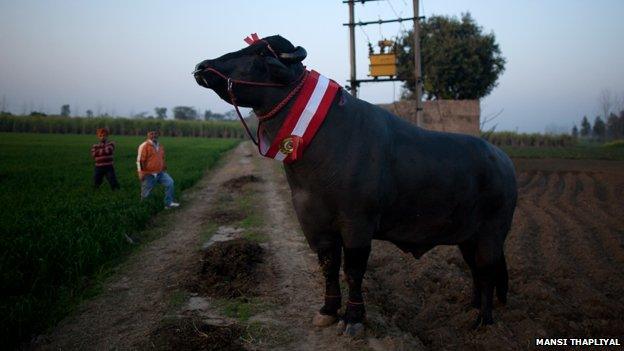
India is the world's top milk producer. More than half of its milk comes from buffaloes, even though the country's 108 million buffaloes are outnumbered by its 200 million cows.
India is home to 57% of the global buffalo population. There are 13 recognised breeds in the country - experts say some of them are among the best in the world.
On the top of the pyramid are the Murrah water buffaloes, mostly found in northern and central India. There are six million of this breed in Haryana alone.
Murrah buffaloes are in particular demand for their high milk yield - an average of 7 litres per day, but some produce more than three times this amount. High-fat buffalo milk - thicker than cow's - is used for making sweets and mozzarella cheese. The male's semen also fetches a good price.
Buffaloes are also more resistant to diseases than cows in tropical countries such as India. Typically a cow suffers from infertility and udder infection after three lactation seasons over three years and is often sold off cheaply - the cow is a sacred animal for Hindus, and many states do not allow them to be slaughtered.
A buffalo, by contrast, will easily last 10-15 lactation seasons before the animal is sold to the slaughter house.
No wonder then that beef - 80% of it from buffaloes - is now India's top agricultural export, beating the more famous basmati rice.

Subscribe to the BBC News Magazine's email newsletter to get articles sent to your inbox.
- Published9 August 2013
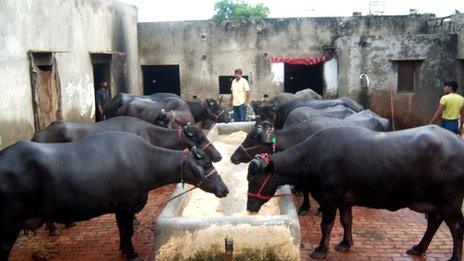
- Published16 February 2012
